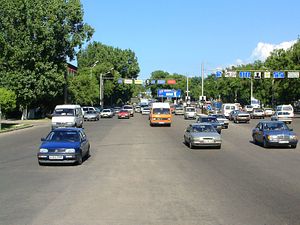Anyone who has had the pleasure of traveling to Central Asia has unfortunately also experienced the potential for terror. I am, of course, talking about how scary driving in the region can be.
Last week, the Washington D.C.-based Center for Strategic and International Studies, released a report on road safety in Kazakhstan titled “Safety on the New Silk Road.” While the report’s scope was relatively narrow — focusing on infrastructure improvements and eschewing deeper discussion of topics like enforcement of traffic laws and education — it was well received for addressing a mundane but critical issue.
According to the World Health Organization, 1.25 million people died in road accidents in 2013, a number which has largely plateaued since 2007. The United Nation’s Sustainable Development Goals include halving road deaths and injuries by 2020. The WHO’s 2015 Global Report on Road Safety notes that 90 percent of road traffic deaths are in low- and middle-income countries, which account for only 54 percent of the world’s registered vehicles.
Kazakhstan, classified by the World Bank as a an upper middle-income country, had nearly 4 million registered vehicles in 2013 and more than 3,200 people died in road-related accidents. The estimated road traffic death rate per 100,000 people was 24.2, the highest among 52 European and Central Asian countries included in the WHO report.
According to an Asian Development Bank report on regional road safety in Central Asia, road accidents are the sixth leading cause of death in the region. In Kazakhstan, the ADB estimated that the cost of road crashes exceeded $9 billion annually.
The CSIS report analyzed road quality and crash data for 13,000 kilometers of Kazakh highways, 13.4 percent of the country’s highway network. “For developing economies like Kazakhstan” the report states, “Asia’s infrastructure push offers opportunities to improve road safety.” With Kazakhstan’s native development programs, Nurly Zhol, and China’s One Belt One Road focusing largely on building connective infrastructure, the road boom is on.
The report goes into detail on road conditions: 76 percent of the roads examined were undivided two-lane roads; 45 percent of the Asian Highway Network (AHN) road segments “have less than half their surface in good condition”; and roads within the ADB’s Central Asia Regional Economic Cooperation (CAREC) program lack shoulders.
One relevant pattern that comes through in the report’s mapping of crash and fatality rates is the fact that major east-west routes are among the most dangerous. “If east-west overland trade expands in the coming years,” the report says, “as promoters of regional connectivity initiatives expect, these areas could experience additional traffic.” With additional traffic, it’s likely additional crashes and deaths will result. The report recommends a number of specific infrastructure improvements to increase road safety from bettering sign and pavement markings to installing rumble strips, median barriers, and “automated enforcement.”
Importantly for those seeking to address Kazakhstan’s road safety issue, the report breaks down provided data to identify the primary type and cause of crashes in specific stretches of highway. Single vehicle run-offs (when a car leaves the roadway) and head-on crashes are the primary crash types on the CAREC roads examined in the report, with overtaking errors and speeding primary causes.
Unsurprisingly, the analysis showed that “most crashes are related to infrastructure deficiencies and noncompliance of the drivers to traffic rules and regulations.”
Unfortunately, the report did not delve into issues of enforcement, public awareness, and driver education — critical parts of road safety.
The Overseas Security Advisory Council, established under the auspices of the U.S. Department of State’s Bureau of Diplomatic Security, in its 2016 Crime and Safety report on Astana (with similar comments in the Almaty report), notes that Kazakh drivers “sometimes disregard traffic signals, disobey traffic laws, drive after excessive alcohol consumption (despite official ‘zero-tolerance’), drive into oncoming lanes of traffic, and move at excessive speeds — including during adverse weather.” The report also says that “many drivers ‘buy’ their licenses and, therefore, have received little/no driver’s education.”
While the CSIS report is important, directing attention at an ordinary but critical issue, it is but one piece of the puzzle. Improvements in infrastructure design can yield improvements in safety, but as the report itself notes, Class 1 road segments (which “provide the highest pavements standards for safety”) resulted in about 58 percent of all accidents in Kazakhstan in 2010 and 51 percent of fatalities. Nice roads and good signage cannot, alone, change driving behavior.
Hopefully, as it invests in road improvements Astana will also look to addressing issues of corruption and policing (and corruption in policing). This will be important to not just constructing roads to the highest standards but also enforcing important road safety laws. Worth revisiting in this regard is a 2012 anecdotal news story about a lawyer in Kazakhstan who had become fed up with being pulled over arbitrarily. “The officers didn’t want to write him a ticket,” the Internews report recounted, “they counted on drivers, unsure of their rights and eager to be on their way, who would be willing to pay a small ‘fee’ directly to the officer in order to settle the matter on the spot.” His fix was installing a dash-cam, memorizing traffic laws, and starting an organization to provide information to drivers and legal assistance to Kazakhs fighting tickets.

































